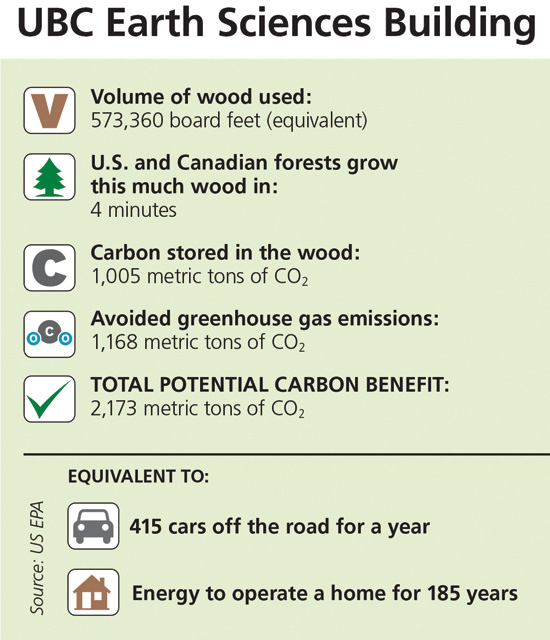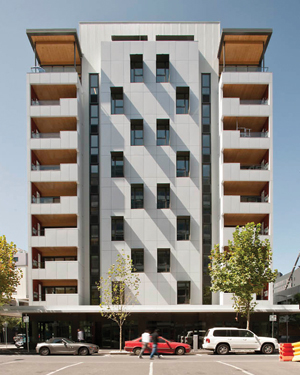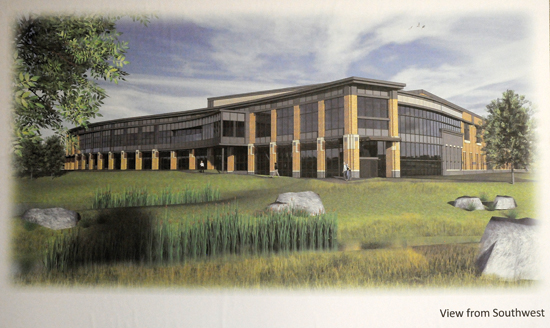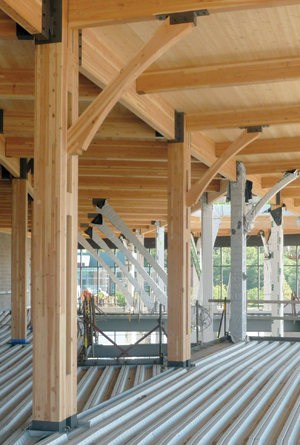Cross Laminated Timber
Environmental performance. Manufactured using wood from sustainably managed forests, CLT provides a number of environmental benefits in addition to energy efficiency.
Wood grows naturally and is renewable. Life cycle assessment (LCA) studies also show that wood outperforms steel and concrete in terms of embodied energy, air pollution and water pollution, and LCA studies are underway on CLT specifically. Wood also has a lighter carbon footprint because wood products continue to store carbon absorbed by the trees while growing, and wood manufacturing requires less energy and results in less greenhouse gas emissions.8
| Will CLT Lead to Forest Resource Depletion? |
Extensive research has been done to ensure that CLT will not create a challenge to the sustainability of North American forests. The basic question was asked: if designers begin to replace construction materials typically used in commercial buildings with mass timber products such as CLT, will we create an unsustainable trend leading to forest resource depletion? Based on analysis of market projections and forest growth-removal ratios, the answer is no. Stringent sustainable forest management practices in the U.S. and Canada restrict harvesting levels, while maintaining other forest values such as biodiversity and wildlife habitat.9 In the U.S., less than 2 percent of the standing tree inventory is harvested each year while net tree growth is close to 3 percent.10 In Canada, less than 0.2 percent of the forest resource is harvested annually and all forests on public land must be successfully regenerated.11 |
Carbon storage is an important attribute of wood structural components, which typically stay in place over long periods. With CLT, the stored carbon mass of the wood is significant. For example, calculations done for The Crossroads estimated the total potential carbon benefit of the wood used just in the CLT portion of the building at 692 metric tons of CO2 (equivalent), which compares to keeping 132 cars of the road for a year, or providing total energy to operate a home for 59 years.
Depending on the manufacturer and other factors, the wood used in North American CLT products may be a factor in LEED certification or other green building rating systems, for example when the wood comes from certified forests or from forests killed by mountain pine beetles.
 |
Estimated carbon benefits of the Earth Sciences Building. Estimated by the Wood Carbon Calculator for Buildings (www.woodworks.org), based on research by Sarthre, R. and J. O’Connor, 2010, A Synthesis of Research on Wood Products and Greenhouse Gas Impacts, FPInnovations. Note: CO2 on this chart refers to CO2 equivalent. Photo courtesy of U.S. WoodWorks |
|
CASE STUDY Forté |
||
Owner: Lend Lease Numbers tell a powerful story when it comes to Forté. It’s Australia’s first CLT building and the first 10-story CLT building anywhere. Research and development was a three year process, followed by a year of design and 10 months of construction from site preparation to completed building. Although Lend Lease cites benefits such as speed of installation and lightweight materials (a particular advantage given the site’s poor soil conditions), the three-year investment in R&D had more to do with the company’s desire to demonstrate that sustainability can be cost effective in a large commercial development. Forté is the first residential building in Australia to achieve a ‘5 Star Green Star As Built’ rating, which is similar to LEED Platinum. “The construction industry is one of the worst in the world for polluting,” says Daryl Patterson, Head of Operational Excellence and Development for Lend Lease. “If we want to do something about this, we have to challenge the materials we’re building with. Among other things, we need to place a greater focus on embodied carbon in addition to operational energy efficiency.” As it turned out, the use of CLT helped Lend Lease achieve its objective of “as close to a net zero carbon building as possible.” Between the carbon sequestered in the wood itself and the greenhouse gas emissions avoided by not using steel or concrete, Forté kept approximately 1,450 metric tons of carbon dioxide (equivalent) out of the atmosphere. It also set the stage for additional carbon savings in future CLT developments.12 |
| CLT and Environmental Product Declarations |
Environmental Product Declarations (EPDs) are a means of presenting environmental information in a standardized way, independently verified by a third party. A common part of decision making elsewhere in the world, they are relatively new to the U.S., produced mainly by large manufacturers or industries committed to being leaders in environmental performance, and used by a relatively small number of design practitioners with the same objective. Governed by international standards (ISO 14025, ISO 21930 and others), EPDs are based on life cycle assessment, which is a rigorous study of inputs and outputs over a product’s lifetime and the associated environmental impacts of those flows to and from nature. EPDs are currently available for two CLT products manufactured in North America.13 Prepared by research organization FPInnovations, both consider all aspects of production from cradle to gate—i.e., from the extraction of raw materials through final production of the CLT. They provide life cycle data on primary energy use as well as impact categories such as global warming potential, smog potential and ozone depletion potential. In terms of carbon footprint, the EPDs conclude that both products have a negative carbon balance leaving the mill gate, which means the amount of carbon sequestered in the wood (absorbed from the atmosphere while the trees were growing) is greater than their cradle to gate carbon emissions. Increasing interest in EPDs reflects a growing demand for sustainability in every aspect of a building’s design, construction and operation, and the recognition that this cannot be evaluated without transparent, verifiable data. Their growing use will allow designers to compare products in the same category in a much more transparent and meaningful way than is otherwise possible. The information contained in EPDs is quantifiable and verifiable—but it is not the final word, by any means. EPDs are complementary to other third-party independent certifications such Energy Star labels and forest certification programs (for example, Forest Stewardship Council, Sustainable Forestry Initiative, and Programme for the Endorsement of Forest Certification). EPDs remain only one of many reporting mechanisms, and product certification continues to serve important functions. Products have other impacts besides those covered by EPDs, involving human and social values such as fair practices, biodiversity, and many others. In the case of wood products, for instance, sustainably managing forests with future generations in mind, conserving biodiversity, and protecting other values related to forests have great worth and complement the parameters measured in an EPD. Together, EPDs and forest certification provide a more complete picture of the environmental attributes of a forest product. |
Resource efficiency. CLT contributes to efficient use of the resource in several ways. One of the advantages of CLT is that it can make use of smaller-dimension material that might not otherwise be used in structural applications. Also, since CLT panels are manufactured specifically for each project, there is almost no job site waste, and manufacturers can re-use any fabrication scraps for stairs and other architectural elements, or as biofuel.
In terms of overall resource use, the distinction between light-frame and “heavy” construction is important. CLT was developed not as a replacement for light-frame construction, but as a low-carbon alternative to “heavy” construction materials such as concrete and steel in building applications where light-frame construction is less appropriate—in taller buildings, certainly, but also others, such as an industrial warehouse with 40-foot walls that need to withstand the impacts of heavy machinery, or a Class A office building where few partition walls and minimal floor vibrations are desired. A CLT building may require more total wood than a light-frame building, but when compared to steel or concrete in applications where all three are potentially applicable, advantages such as renewability, carbon off-sets, low embodied energy and operational energy efficiency make CLT an environmentally preferable choice.
|
CASE STUDY The Crossroads |
|||
Owner: Promega Corporation
The project team for The Crossroads evaluated several types of structural systems during the initial design phase. “There was no particular assumption in terms of what the structural material needed to be,” says David Rousseau from Archemy Consulting, design consultant for Promega. “I think we may have even initially assumed it would be a steel structure since that’s what we were using for the GMP portion of the project.” Cross laminated timber came up because it’s an innovative material and the team knew it wanted to create a unique space, but it also served the design in key ways. “Together with glulam, it was a natural fit for the warm aesthetic we wanted to create,” says Rousseau. “Plus, we wanted to have a high quality, exposed roof deck with long spans and minimum on-site construction complexity. CLT met the criteria.” Aitor Sanchez-Prado, structural engineer and principal for EwingCole, said, “CLT provided us with a solution that met all of our architectural and engineering goals. Architecturally speaking, our decision to use CLT for the roof of The Crossroads allowed us to leave the interior ceiling surfaces exposed, which certainly enhanced the glulam beam and column superstructure. From an engineering point of view, the CLT panels gave us the ability to increase deck spans while supporting heavily loaded areas due to snow drifts. In addition, the CLT panels allowed us to design an overhang of three feet while maintaining a slim profile.” |












